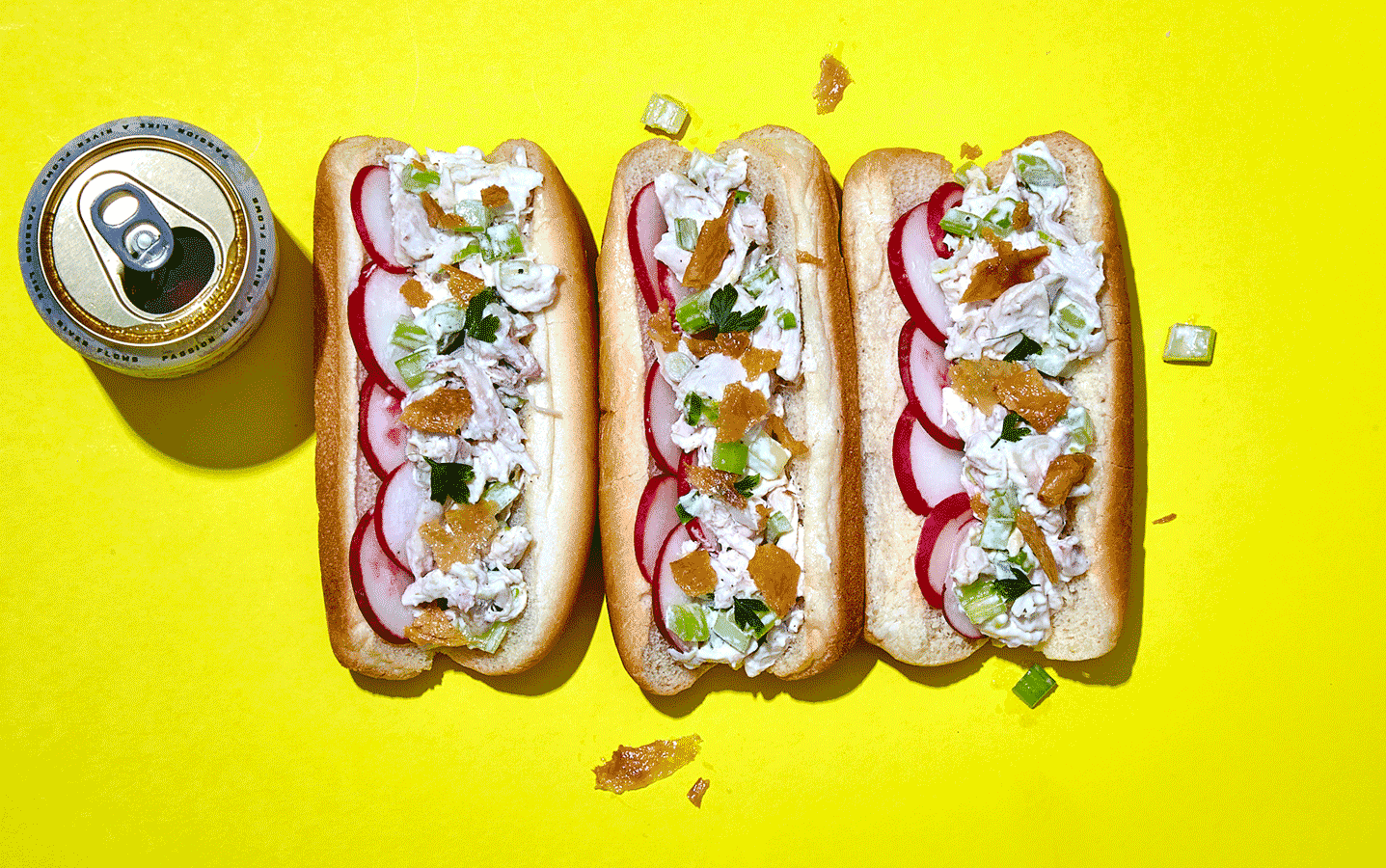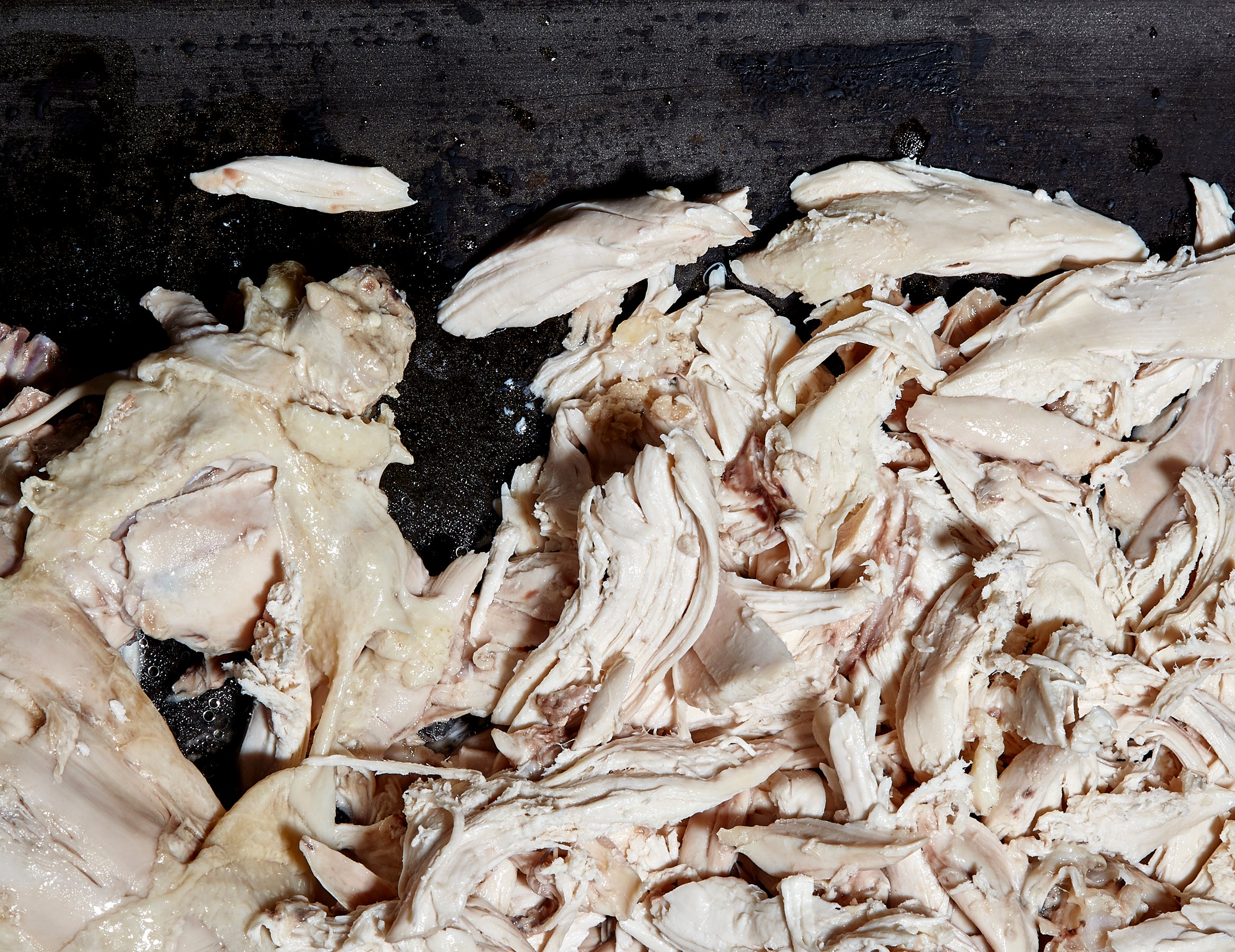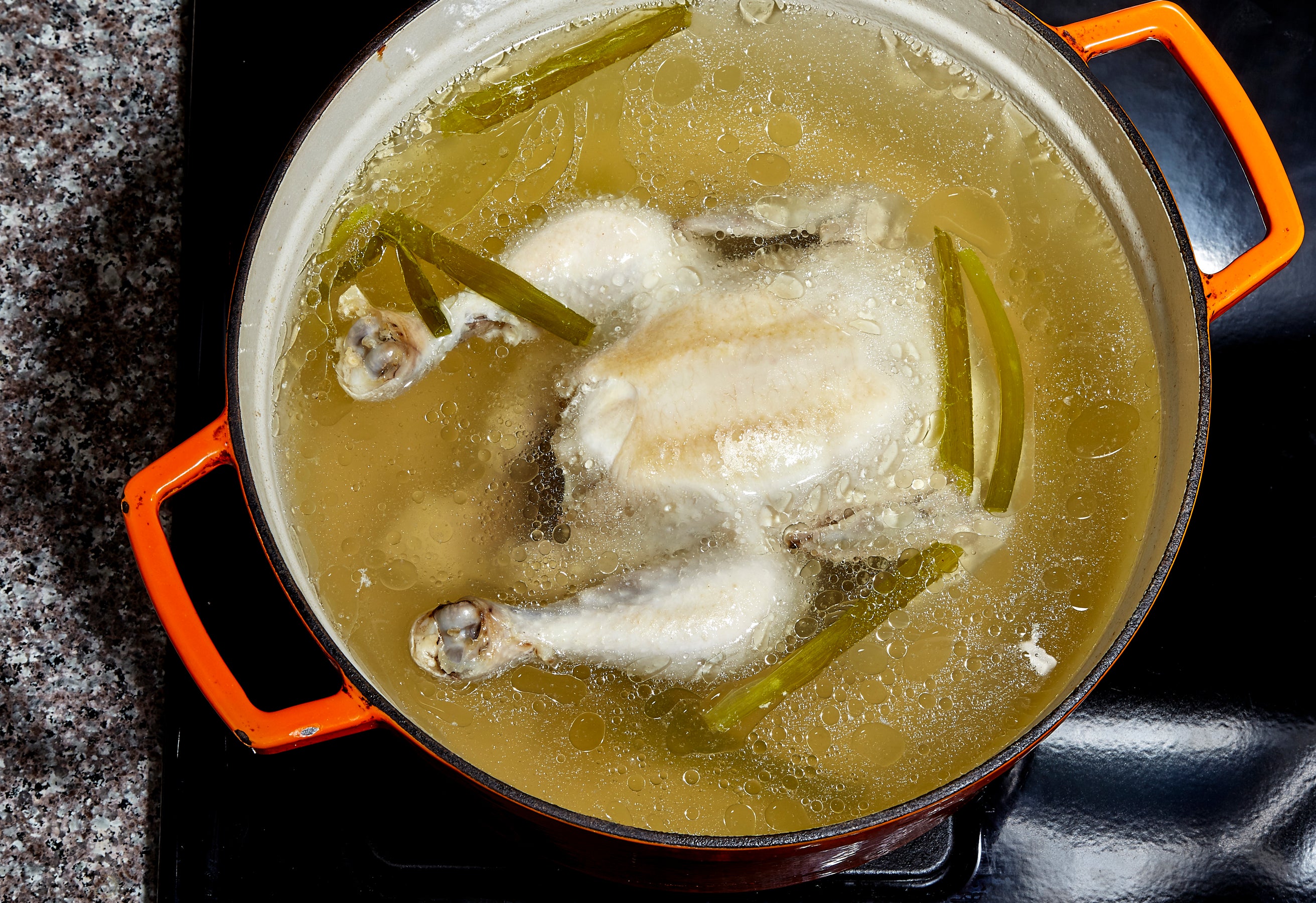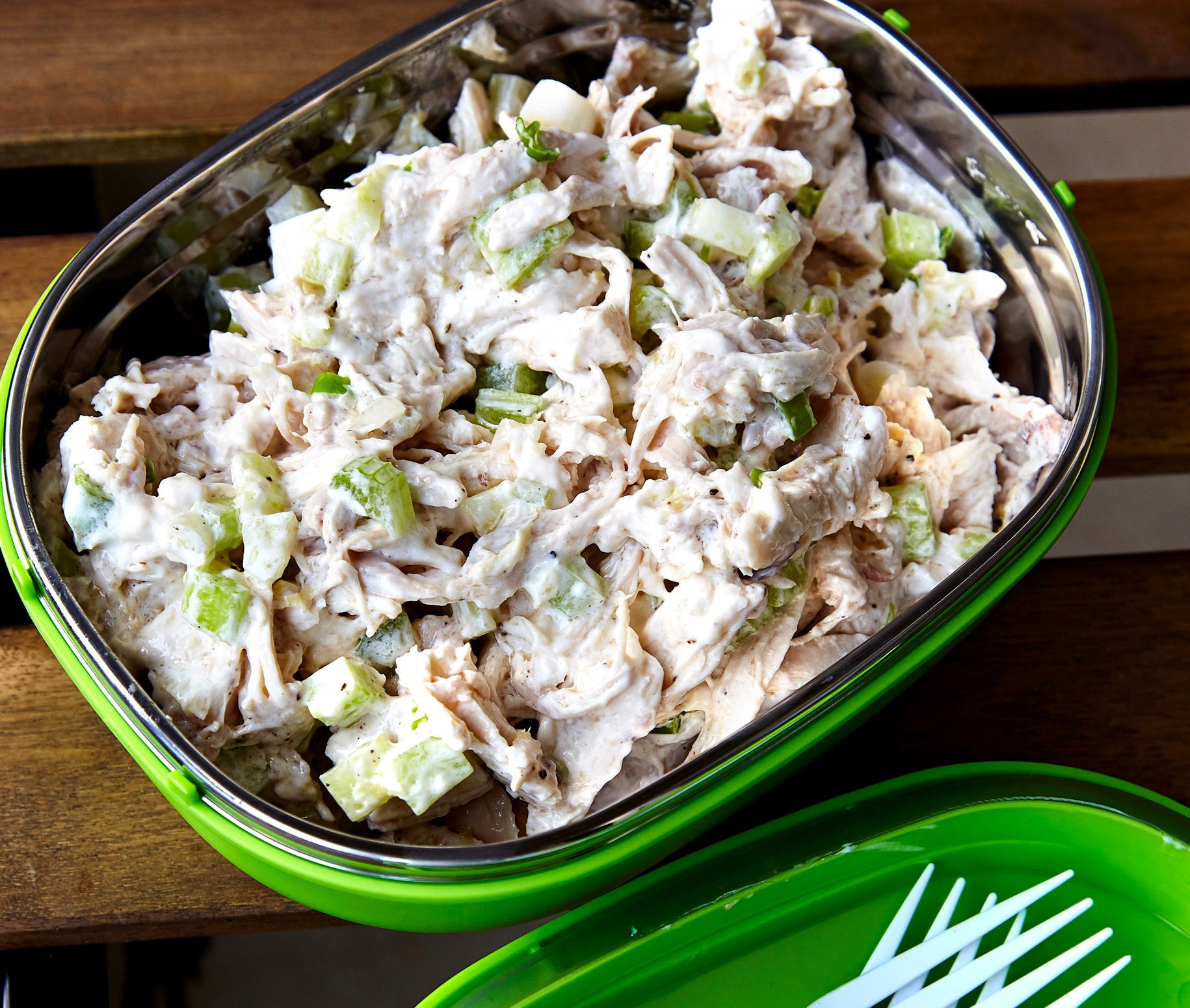
American chicken salad wins a Chinese technique.
My best friend fell in love over cold chicken salad in a park. We’d thrown a picnic around this dish, and the stranger she would marry years later arrived with his own proud version. Over a spread of mismatched Tupperware and paper plates propped on the grass, I watched as their minds and desires melded like mayonnaised chunks of chicken and celery.
I, too, have had love affairs over cold chicken—or rather, with it. Furtive dips into the fridge for leftover pieces of Cantonese soy sauce chicken, with a tub of solidified ginger-scallion sauce always nearby, were a childhood penchant of mine. Nibbling at their jellied wing tips, peeling away strands of cold, salty meat like string cheese—this was much more exciting than the deli cold cuts I was expected to eat between sandwich bread. Mayonnaise made me squirm back then, but I’ve come to embrace it now, exploring all the ways to marry it with cold chicken.
Seasoned with curry, Cajun, or jerk spices, studded with peppers, pickles, jicama, or almonds, chicken salad is a perfect playground for riffing on an American classic. It’s a shame that, as a culture, we have largely stopped doing so since the early 1900s, when a nod to Waldorf salad, with grapes and walnuts, became de facto. Unlike potato salad, which never seems to lack for new ideas and audiences, the cold chicken salad is as unfashionable as sliced white bread.
Yet cold, moist chicken holds subtle thrills. When it’s served cold, without the distraction of crispy skin (the earmarks of a classically fried or roasted bird), we can better concentrate on the nuances of the chicken itself. But except in a few iconic dishes, like chicken salad, we rarely exploit these singular sensations.
Many Asian cuisines have made good use of cold, shredded, typically leftover chicken. See Vietnamese goi ga or Thai khao yum gai, drenched in a shower of fish sauce and lime juice. A similar mixture of shredded vegetables and chicken is often tossed with cold noodles, or liang mian, in Taiwan. Or splashed with a ma-la combination of Sichuan peppercorns and chile oil, like bon bon chicken salad. But if you’re looking for chicken that’s meant to be served cool, or at room temperature, rather than using up what’s been held over in the fridge, you will find a thread of Chinese and Southeast Asian dishes that employ a common gentle poaching technique.
In Singapore, Hainanese chicken and rice is a national obsession. In Thailand, khao man gai is similarly revered. And in China, Cantonese white cut chicken, or bai qie ji, is a refreshing component for a multi-course meal. A chicken poached in much the same manner can be sliced up and dressed, as with the Sichuan kou shui ji, or it can be soaked in rice wine, resulting in the Shanghainese zui ji, or drunken chicken.
Grace Young, author of The Wisdom of a Chinese Kitchen, offers a few notes on the latter, passed down from her mother, who lived in Shanghai for a time. It involves twice-poaching and cooling down a whole chicken in ice water, then air-drying before soaking the chicken with Shaoxing rice wine. Her mom would then serve it with minced scallion and ginger oil.
“The double-poaching resulted in a super succulent chicken, and the air-drying helped the chicken better absorb the rice wine,” says Young.
Although drunken chicken tends to be served severely chilled in restaurants, that wasn’t always the case; refrigeration wasn’t common in China until the mid-20th century, and still isn’t in some rural parts. “In Chinese cooking, a cold appetizer is not necessarily cold. It can be room temperature,” says Young. “And on a hot day, it’s still refreshing.”
Hainanese chicken and rice was popularized by settlers from China’s Hainan province to Southeast Asia, according to Kian Lam Kho, the author of Phoenix Claws and Jade Trees, who grew up in Singapore. He says he can remember seeing Hainanese construction workers in his city growing up, wearing distinctive red hats.
“When it was brought into Southeast Asia, someone decided to use the poaching liquid because there’s this rich, beautiful chicken stock after you cook it. That’s how the modern form of Hainanese chicken arose,” he says.
He explains that its whole-poached chicken technique is essentially the same one that’s used all over China, in dishes like bai qie ji. “The Hainanese just took it and made it well known,” says Kho.
Hainanese chicken with rice is prepared similarly to khao yum gai in Thailand; it’s just seasoning and serving options that differ slightly—poached with or without aromatics, like ginger, galangal, scallion, or shallots, served with or without chicken-infused rice, soup, cucumbers, and sauces like chile-garlic sauce or ginger-scallion oil. The key is to very slowly poach the chicken, without allowing the water to boil, to achieve an incredibly soft, juicy meat that demands your attention, despite having virtually no color. And the chicken should never be reheated once it’s cooked, which would ruin that pristine texture and defeat the whole process. That is why we often find it served room temperature or cold.
“The idea is the same as sous vide: You want to keep it at the same temperature and don’t want it to go super high,” Kho explains. “So you maintain the chicken at a very low cooking temperature.”
So what if, instead of using leftover roast chicken, I rendered a chicken so delicate and moist that it made chicken salad sing practically on its own virtues? That is, what if I put the focus on the chicken in a chicken salad, rather than the other stuff—and gave a classic Chinese dish a uniquely American riff?
I found a recipe for “Cold Cut Chicken” in The Joyce Chen Cookbook, published in 1962. The famous TV chef writes in the endnote: “My husband, Thomas, was once in a streetcar in Shanghai and overheard two women talking about how to make good cold cut chicken. He got some ideas from their talking, and therefore I was able to improve my technique in making this dish… the soaking in hot water (not boiling water) makes the chicken juicy and tender.”
I followed her recipe, dipping a whole chicken into just-boiled water and turning off the heat. Then an hour later, I almost brought the water to a boil before turning off the heat again. An hour later, I removed the bird from the water, and let it drain. Once cool, the meat felt almost as tender and moist as if it had been raw, only it was white. Touched by a knife, it yielded like jelly.
In her New York Times Style Magazine essay on contemporary Asian-American cuisine, Ligaya Mishan writes, of an iceberg wedge salad prepared by Hawaiian chef Chris Kajioka: “It’s not so much a salad as a cheeky biography of it by the barbarian at the gates, achieving the quintessence of an American classic through Asian ingredients.”
We can also strive toward the quintessence of American classics through Asian techniques. Maybe what chicken salad really needed was some cold, creamy, and utterly tender poached chicken to spread on bread. And maybe, throughout all my trials with chicken salad, what I really wanted was to make a space for my two worlds—Asian and American—to coexist.


